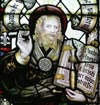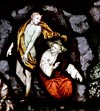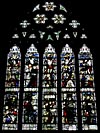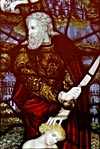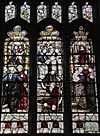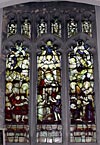For this church:    |
|
Key to Glass |
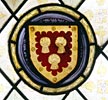 Kempe's trademark Kempe's trademark |
The church has one of the most important sets of stained glass windows by Charles Kempe in the country. They are important because they date from Kempe's middle period (1883-1895) and demonstrate the studio's full range of subjects and variety of styles.
Most of the windows were commissioned and donated by Canon John Godber who, although never vicar of Hucknall, had been brought up in the town and had a life-long affection for the church. Godber and Kempe had been contemporaries at Pembroke College, Oxford.
Chancel
1.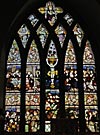 The east window dates from 1883 and shows scenes associated with the Crucifixion and Resurrection.
The east window dates from 1883 and shows scenes associated with the Crucifixion and Resurrection.
It is commonly thought that one of the figures resembles Lord Byron.
2.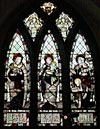 The window at the east end of the south wall dates from 1888 and depicts St Mary Magdalene, The Virgin Mary with the Infant Jesus and St Elizabeth with the Infant St. John. The inscription reads:
The window at the east end of the south wall dates from 1888 and depicts St Mary Magdalene, The Virgin Mary with the Infant Jesus and St Elizabeth with the Infant St. John. The inscription reads:
| For the adornment of this church & in memory of Elizabeth wife of John Godber this window is erected A.D. 1888. |
South Transept
4. The window depicts, from left to right, St Peter, St John the Evangelist and St James the Pilgrim. It is not by Kempe. The inscription reads:
The window depicts, from left to right, St Peter, St John the Evangelist and St James the Pilgrim. It is not by Kempe. The inscription reads:
To the Glory of God & to the memory of George & Rachel Stevenson of this Parish |
South Aisle
10.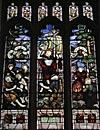 The subject of the easternmost window in the wall of the south aisle is The Charge to Peter. The inscription reads:
The subject of the easternmost window in the wall of the south aisle is The Charge to Peter. The inscription reads:
To the glory of God and in grateful recognition of the |
Visitor Centre
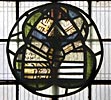 The Visitor Centre was formerly the baptistry. The plain window in the south-west corner includes a roundel containing fragments of medieval stained glass.
The Visitor Centre was formerly the baptistry. The plain window in the south-west corner includes a roundel containing fragments of medieval stained glass.
Tower
13.The west window replaced the west door in the late 19th century and shows the Presentation of the Infant Jesus in the Temple.
North Aisle
North Transept
16.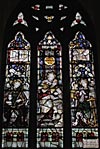 The window is an allegorical interpretation of the three great Christian virtues, Faith, Charity and Hope. The inscription reads:
The window is an allegorical interpretation of the three great Christian virtues, Faith, Charity and Hope. The inscription reads:
In grateful recollection of the life |
Lady Chapel
The windows in the Lady Chapel were produced by Alexander Gascoyne of Nottingham who had trained with Kempe.
 |
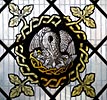 Detail showing
Detail showingPelican feeding its young |
The window was given in 1920 by the Hucknall Company of the Boys Brigade in memory of their fallen comrades and shows Agnus Dei, symbol of the Risen Jesus, and the Pelican feeding its young, a symbol of Jesus feeding his people in the Eucharist.
Chancel arch and Clerestorey windows
The chancel arch has an angelus window, composed of six roundels filled with angel heads.
The six clerestorey windows also portrayed angels but were removed in 1966 and the glass re-installed in churches in Ibstock (Leicestershire), Selston and Bestwood.





